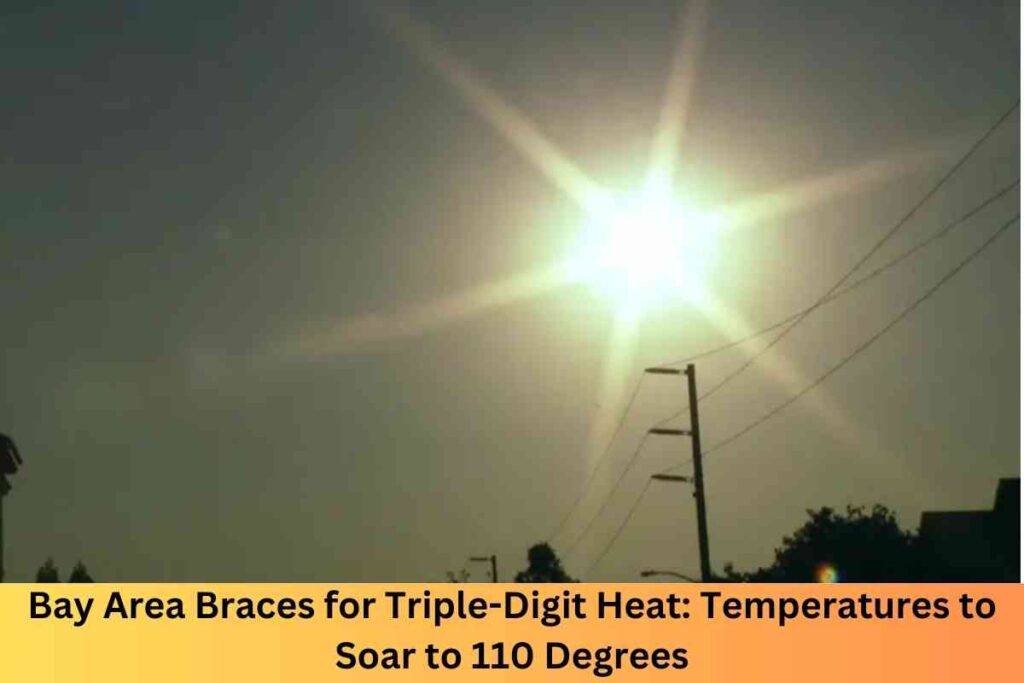Bay Area Braces for Triple-Digit Heat: Temperatures to Soar to 110 Degrees:- As residents across the San Francisco Bay Area face record-breaking heat this week, forecasters warn of extreme temperatures that could reach up to 110 degrees Fahrenheit in inland regions by Wednesday, October 2, 2024. The National Weather Service (NWS) has issued an Excessive Heat Warning, underscoring the seriousness of the event as it threatens both public health and infrastructure. Here’s an in-depth look at what to expect during this intense heat wave and how to stay safe.
Heat Wave Overview
The Bay Area, known for its relatively mild climate, is currently experiencing a significant heat wave, driven by a high-pressure system known as a “heat dome.” This weather phenomenon traps hot air, creating stifling conditions that will impact both coastal and inland areas. The excessive heat warning, issued by the NWS, is expected to remain in place until Wednesday evening, with some of the highest temperatures being recorded in East Bay and North Bay areas like Concord and Livermore.
Also, Read Better Man” Teaser: Robbie Williams Played by a CGI Monkey in Surreal Musical Biopic
In inland cities, such as Concord, temperatures could spike as high as 108 degrees, while Livermore may experience highs of 106 degrees. Even areas that typically enjoy cooler conditions, such as downtown San Francisco, are expected to see temperatures reach an unusual 96 degrees.
Health and Safety Warnings
Amid these soaring temperatures, officials are urging Bay Area residents to take precautions against heat-related illnesses. Prolonged exposure to high temperatures can lead to heat exhaustion, heat stroke, and other health risks, particularly for vulnerable groups such as children, the elderly, and those with pre-existing medical conditions.
Public health experts recommend avoiding outdoor activities during the peak heat of the afternoon, staying hydrated, and seeking air-conditioned environments whenever possible. The NWS also reminds the public to never leave pets or children unattended in vehicles, as interior car temperatures can rise to dangerous levels in minutes.
Impact on Air Quality
In addition to the heat, the Bay Area Air Quality Management District has issued a Spare the Air Alert due to unhealthy levels of smog and pollution, exacerbated by the high temperatures. Smog forms more readily in hot, stagnant air, increasing respiratory risks for people with asthma, bronchitis, and other lung conditions.
Red Flag Warnings and Fire Danger
The extreme heat is not only a health hazard but also significantly increases the risk of wildfires. A Red Flag Warning has been issued for parts of the Bay Area, particularly inland regions such as Monterey County, where offshore winds combined with the high temperatures could lead to critical fire conditions. With humidity levels dipping below 30% and winds gusting between 20 to 30 mph, fire agencies are on high alert for potential outbreaks.
Energy and Infrastructure Strain
The heat wave also significantly strains energy resources, as residents crank up air conditioning to stay cool. Pacific Gas and Electric Company (PG&E) has warned of potential power outages due to increased energy demand, with the possibility of Public Safety Power Shutoffs (PSPS) in some regions to reduce the risk of fires from power lines. This will likely affect areas where infrastructure is more vulnerable, particularly in rural and wildfire-prone zones.
PG&E advises residents to prepare for potential blackouts by charging essential devices, keeping extra batteries on hand, and having a plan for staying cool without electricity.
Record-Breaking Temperatures and Climate Trends
The ongoing heat wave is part of a broader trend of rising temperatures in California and across the globe. October is usually a transitional month for the Bay Area, with cooler, fall-like weather expected. However, in recent years, climate change has disrupted typical weather patterns, leading to unseasonably hot conditions.
The NWS expects several cities in the Bay Area to break daily high-temperature records, with many places surpassing previous October benchmarks. For example, San Jose hit 100 degrees on Tuesday, smashing the previous record of 97 degrees set in 1980. Experts predict that while the heat will begin to subside by Thursday, inland areas will continue to experience temperatures in the high 90s through the weekend before a more significant cooldown next week.
Preparing for Extreme Heat
In light of the heat, local authorities are opening cooling centers across the region where residents can find relief in air-conditioned facilities. Public libraries, community centers, and malls are some of the designated cooling centers, particularly in cities like Oakland, San Jose, and Livermore. The cities of San Francisco and Berkeley have also set up emergency shelters to accommodate those in need.
Local officials urge residents to:
- Check-in on vulnerable neighbours, particularly the elderly and those living alone.
- Use fans and portable air conditioners to cool down small spaces.
- Wear light-coloured, loose-fitting clothing.
- Plan errands for early in the morning or late in the evening when temperatures are lower.
Conclusion
As the Bay Area braces for the peak of this extreme heat wave, it is essential to stay informed and take necessary precautions. Whether you’re in the scorching inland regions or facing uncharacteristically warm temperatures by the coast, this heat event is a stark reminder of the increasing unpredictability of weather patterns in a changing climate. With the right preparation and community support, residents can minimize the risks associated with this severe weather. Stay hydrated, stay cool, and stay safe as we navigate this historic heat wave.
Follow your local Authorities and weather services for updates on local weather conditions, power shutoffs, and cooling centers.

